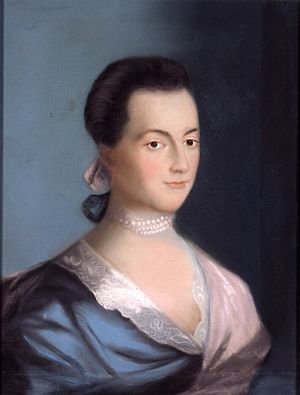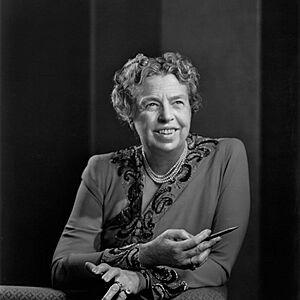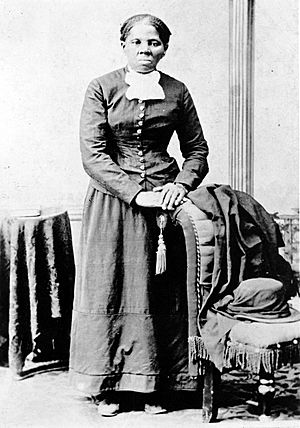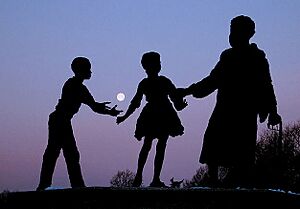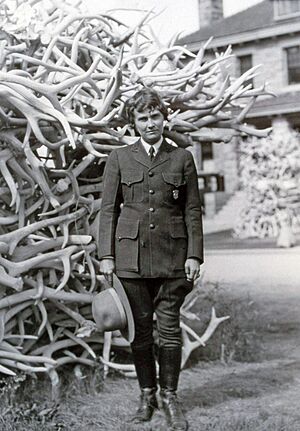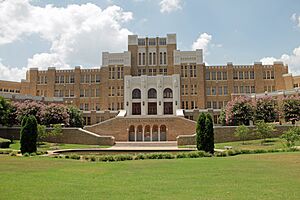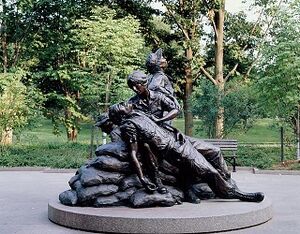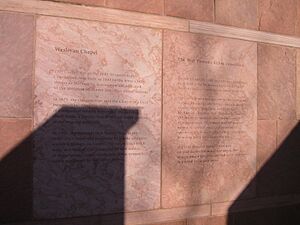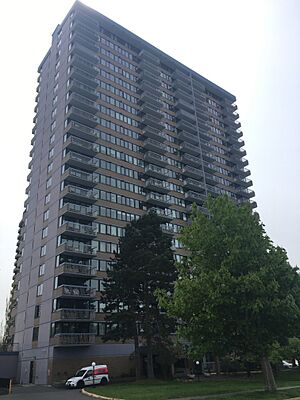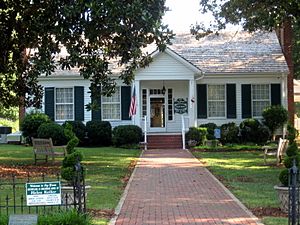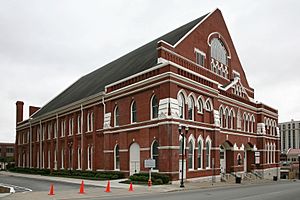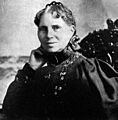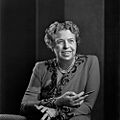Women's history sites (National Park Service) facts for kids
The National Park System helps us remember and understand the important role women have played in American history. Many national parks, monuments, and historic sites focus on women's history. Others include women's stories in their programs and preservation efforts. This list shows some of these special places. You can also find an article about Women in the National Park Service.
Contents
- National Parks and Historic Sites Honoring Women
- Pioneering Women and Leaders
- Abigail and Louisa Adams: First Ladies of History
- Clara Barton: Founder of the Red Cross
- Eleanor Roosevelt: First Lady of the World
- Marjory Stoneman Douglas: Protecting the Everglades
- Harriet Tubman: Conductor on the Underground Railroad
- Kate Mullany: Labor Union Pioneer
- Maggie L. Walker: Banking Trailblazer
- Mary McLeod Bethune: Educator and Activist
- Rosie the Riveter: Women at Work in WWII
- Julia Dent Grant: First Lady of the Civil War Era
- Narcissa Prentiss Whitman: Missionary Pioneer
- Herma Albertson Baggley: First Female Park Naturalist
- Sites of Social Change and Equality
- Belmont-Paul Women's Equality National Monument: Fighting for Rights
- First Ladies National Historic Site: Honoring Presidential Spouses
- Johnstown Flood National Memorial: Red Cross Relief
- Little Rock Central High School: Desegregation and Women's Action
- Lowell National Historical Park: Women in Industry
- Nicodemus National Historic Site: African American Settlers
- Sand Creek Massacre National Historic Site: A Tragic Event
- Vietnam Women's Memorial: Honoring Women in Service
- Women's Rights National Historical Park: Birthplace of Women's Rights
- Pioneering Women and Leaders
- National Historic Landmarks Connected to Women's History
- Intermountain Region Landmarks
- Midwest Region Landmarks
- Daisy Bates House: Civil Rights Activism
- Dr. Susan LaFlesche Picotte Memorial Hospital: Native American Doctor
- Fair Lane: Clara Ford's Influence
- Golda Meir School: A Future Prime Minister's Education
- Harriet Taylor Upton House: Suffrage Advocate
- Ida B. Wells-Barnett House: Journalist and Civil Rights Leader
- Marie Webster House: Quilting Art and History
- Meadow Brook Hall: Matilda Dodge Wilson's Estate
- Frances Willard House: Activist and Author
- Hull House: Jane Addams' Social Work
- Madame C.J. Walker Manufacturing Company: Entrepreneurial Success
- Pewabic Pottery: Mary Chase Perry Stratton's Art
- Willa Cather House: A Novelist's Childhood Home
- National Capitol Region Landmarks
- Charlotte Forten Grimké House: Abolitionist and Educator
- Frances Perkins House: First Female Cabinet Member
- General Federation of Women's Clubs Headquarters: Women's Organizations
- Mary Ann Shadd Cary House: Journalist and Lawyer
- Mary Church Terrell House: Civil Rights Leader
- Nannie Helen Burroughs School: Vocational Training for Women
- American Red Cross National Headquarters: A Memorial to Women
- Sewall–Belmont House: Women's Suffrage History
- Northeast Region Landmarks
- Birdcraft Sanctuary: Mabel Osgood Wright's Vision
- Bush-Holley House: A Center for Women Artists
- Emily Dickinson Home: A Poet's Sanctuary
- Emma Willard House: Pioneering Educator
- Florence Griswold House: Art Patron's Home
- Frances Perkins Homestead: A Family Legacy
- Fruitlands: Louisa May Alcott's Early Home
- Hamilton House: Sarah Orne Jewett's Inspiration
- Harriet Beecher Stowe House: Author of "Uncle Tom's Cabin"
- Ida Tarbell House: Muckraking Journalist
- Kimberly Mansion: Sisters for Women's Rights
- Lady Pepperrell House: A Colonial Widow's Home
- Liberty Farm: Abby Kelley's Fight for Suffrage
- Lydia Pinkham House: Entrepreneur and Marketer
- MacDowell Colony: A Place for Artists
- Margaret Fuller House: Early Feminist Thinker
- Maria Baldwin House: First African-American Principal
- The Mount: Edith Wharton's Designed Home
- Orchard House: Inspiration for "Little Women"
- Prudence Crandall House: Integrated Education Pioneer
- Rokeby: An Underground Railroad Station
- Sarah Orne Jewett House: Author's Home
- Shelburne Farms: Eliza Osgood Vanderbilt Webb's Model Farm
- The Wayside: Children's Literature Author
- Pacific West Region Landmarks
- Southeast Region Landmarks
- Brown Chapel A.M.E. Church: Civil Rights Marches
- Camp Nelson: African American Women in the Civil War
- Ivy Green: Helen Keller's Childhood Home
- Juliette Gordon Low Historic District: Birthplace of Girl Scouts
- Mar-a-Lago: Marjorie Merriweather Post's Estate
- Marjorie Kinnan Rawlings House and Farmyard: An Author's Home
- Mary McLeod Bethune Home: Educator's Residence
- Mulberry Plantation: Mary Boykin Chesnut's Diary
- Penn School Historic District: Education for Freed Slaves
- Ryman Auditorium: Women in Country Music
- Ybor City Historic District: Women Cigar Workers
- Zora Neale Hurston House: Author's Home
- Images for kids
National Parks and Historic Sites Honoring Women
These special places are part of the National Park System. They tell the stories of amazing women and their contributions.
Pioneering Women and Leaders
Abigail and Louisa Adams: First Ladies of History
At Adams National Historical Park in Quincy, Massachusetts, you can learn about Abigail Adams (1744 - 1818) and Louisa Catherine Adams (1775 - 1852). They were both wives of U.S. Presidents and played important roles in early American history.
Clara Barton: Founder of the Red Cross
The Clara Barton National Historic Site in Glen Echo, Maryland, was Clara Barton's home. She moved there in 1897. Clara Barton founded the American Red Cross, an organization that helps people in emergencies. She started the Red Cross from her home in New York. Her home in Maryland also served as a Red Cross office.
Eleanor Roosevelt: First Lady of the World
The Eleanor Roosevelt National Historic Site in Hyde Park, New York, shows Eleanor Roosevelt's life. She was a wife, mother, writer, and speaker. Born in 1884, she married Franklin Roosevelt in 1905. After her husband's death, she worked at the United Nations. She helped write the Declaration of Human Rights. President Harry S. Truman called her the "First Lady of the World." The site also tells about Val-Kill Industries. Eleanor started this to help local people earn money.
Marjory Stoneman Douglas: Protecting the Everglades
Everglades National Park in Florida is a unique natural area. Marjory Stoneman Douglas wrote a famous book about it called "Everglades: River of Grass." This book, published in 1947, described the Everglades perfectly. She fought hard to protect this natural treasure.
Harriet Tubman: Conductor on the Underground Railroad
The Harriet Tubman Underground Railroad National Historical Park honors Harriet Tubman. She was known as the "Moses of her people." Harriet Tubman was an abolitionist, meaning she fought to end slavery. She was also a suffragist, working for women's right to vote. This park protects the land she knew as a child and as a freedom seeker.
Kate Mullany: Labor Union Pioneer
The Kate Mullany House in Troy, New York, was home to Kate Mullany (1845–1906). In 1864, she started the Collar Laundry Union. This was one of the first labor unions for women.
Maggie L. Walker: Banking Trailblazer
The Maggie L. Walker National Historic Site in Richmond, Virginia, celebrates Maggie L. Walker (1864-1934). She was an African American bank president and newspaper editor. She was the first woman in the United States to start and lead a bank.
Mary McLeod Bethune: Educator and Activist
The Mary McLeod Bethune Council House National Historic Site in Washington, D.C., honors Mary McLeod Bethune. It also tells the story of the National Council of Negro Women, an organization she founded.
Rosie the Riveter: Women at Work in WWII
The Rosie the Riveter/World War II Home Front National Historical Park in Richmond, California, tells about the home front effort during World War II. It especially highlights the important work women did in war industries.
Julia Dent Grant: First Lady of the Civil War Era
The Ulysses S. Grant National Historic Site in St. Louis, Missouri, tells the story of President Ulysses S. Grant. It also shares the life of his wife, Julia Dent Grant (1826-1902).
Narcissa Prentiss Whitman: Missionary Pioneer
The Whitman Mission National Historic Site in Washington, D.C., remembers Marcus Whitman and his wife, Narcissa Prentiss Whitman. They started an Indian mission and school here. They helped the local Native American tribes until they were killed in 1847.
Herma Albertson Baggley: First Female Park Naturalist
Yellowstone National Park in Wyoming, Montana, and Idaho, celebrates Herma Albertson Baggley (1896–1981). She was a Park Ranger, naturalist, and author. She joined the National Park Service in the 1930s. She was the first woman to be a full-time naturalist. She helped write a book about Yellowstone's plants. She also worked to improve living conditions for park employees and their families. This encouraged more women to work in the National Park Service.
Sites of Social Change and Equality
Belmont-Paul Women's Equality National Monument: Fighting for Rights
The Belmont–Paul Women's Equality National Monument in Washington, D.C., became a national monument in 2016. The Sewall–Belmont House has been home to the National Woman's Party since 1929. Here, suffragist Alice Paul and the party worked for the Equal Rights Amendment. They developed new ways to fight for women's equality.
First Ladies National Historic Site: Honoring Presidential Spouses
The First Ladies National Historic Site in Canton, Ohio, was created in 2000. It protects the home of First Lady Ida Saxton McKinley. It also houses the National First Ladies' Library.
Johnstown Flood National Memorial: Red Cross Relief
The Johnstown Flood National Memorial in Johnstown, Pennsylvania, tells about the life of Clara Barton. She was a very important woman in the early American Red Cross. Barton and the Red Cross helped a lot after the Johnstown Flood. Many people and groups worked together to rebuild Johnstown.
Little Rock Central High School: Desegregation and Women's Action
The Little Rock Central High School National Historic Site in Little Rock, Arkansas, is a symbol of the Civil Rights Movement. In 1957, nine African American students, including Elizabeth Eckford and Carlotta Walls LaNier, enrolled there. Federal troops were needed to protect these "Little Rock Nine." When the governor tried to close the schools, the Women's Emergency Committee to Open Our Schools formed. They worked to keep public education open and support desegregation.
Lowell National Historical Park: Women in Industry
At Lowell National Historical Park in Lowell, Massachusetts, you can learn about a big social change in the 1800s. Posters invited young women, aged 15 to 35, to work in mills. These women traveled from far away to try something new. They left their homes and families for a chance at a different life.
Nicodemus National Historic Site: African American Settlers
The Nicodemus National Historic Site in Nicodemus, Kansas, was founded in 1877. African Americans from Kentucky started this town. The site shows how African American men and women helped settle the Great Plains after the Civil War.
Sand Creek Massacre National Historic Site: A Tragic Event
The Sand Creek Massacre National Historic Site in Kiowa County, Colorado, marks a sad event from November 29, 1864. About 700 Colorado militiamen attacked a village of Cheyenne and Arapaho Indians. Many women and children were killed.
Vietnam Women's Memorial: Honoring Women in Service
The Vietnam Women's Memorial in Washington, D.C., is part of the Vietnam Veterans Memorial. It honors the women, mostly nurses, who served in the Vietnam War. It was dedicated in 1993 and designed by sculptor Glenna Goodacre.
Women's Rights National Historical Park: Birthplace of Women's Rights
The Women's Rights National Historical Park in Seneca Falls, New York, remembers the Seneca Falls Convention. This was the first convention for women's rights in the United States. The park includes the Wesleyan Chapel, where the convention took place. It also has the homes of three of the organizers: Elizabeth Cady Stanton, Jane Hunt, and Mary Ann M'Clintock.
National Historic Landmarks Connected to Women's History
These sites are recognized as National Historic Landmarks. They are important because of their connection to women's history.
Intermountain Region Landmarks
Georgia O'Keeffe Home and Studio: An Artist's Retreat
The Georgia O'Keeffe Home and Studio in Abiquiu, New Mexico, was the home of Georgia O'Keeffe (1887-1986). She was a very famous artist of the 20th century.
Japanese American Internment Camps: Women's Resilience
Sites like Granada War Relocation Center (Camp Amache) in Colorado and Heart Mountain War Relocation Center in Wyoming were concentration camps. Japanese Americans, including many women and children, were confined here during World War II. The Topaz War Relocation Center in Utah was another such camp.
Ludlow Tent Colony Site: Miners' Strike and Families
The Ludlow Tent Colony Site in Ludlow, Colorado, was where striking coal miners and their families lived in tents. In 1914, a battle happened there, and several people died, including women and children.
Mabel Dodge Luhan House: An Art Colony Hub
The Mabel Dodge Luhan House in Taos, New Mexico, was the home of artist and art supporter Mabel Dodge Luhan (1879-1962). It was a central place for the Taos art colony in the early 1900s.
Jeannette Rankin: First Woman in Congress
The Rankin Ranch in Montana was the home of Jeannette Rankin. In 1916, she became the first woman elected to the United States House of Representatives.
Midwest Region Landmarks
Daisy Bates House: Civil Rights Activism
The Daisy Bates House in Little Rock, Arkansas, was the home of Daisy Bates (1914-1999). She was a publisher and journalist. Her home was a key place in the fight to desegregate Little Rock High School.
Dr. Susan LaFlesche Picotte Memorial Hospital: Native American Doctor
The Dr. Susan LaFlesche Picotte Memorial Hospital in Walt Hill, Nebraska, was founded in 1913. Dr. Susan La Flesche Picotte (1865–1915) started it. She was the first Native American woman to become a medical doctor.
Fair Lane: Clara Ford's Influence
Fair Lane in Dearborn, Michigan, was the home of Henry Ford, who founded Ford Motor Company, and his wife Clara Ford. The house was designed by architect Marion Mahony Griffin.
Golda Meir School: A Future Prime Minister's Education
The Golda Meir School in Milwaukee, Wisconsin, was attended by Golda Meir from 1906 to 1912. She later became the fourth Prime Minister of Israel.
Harriet Taylor Upton House: Suffrage Advocate
The Harriet Taylor Upton House in Warren, Ohio, was the home of suffrage activist Harriet Taylor Upton (1853-1945). She lived there from 1887 to 1931.
Ida B. Wells-Barnett House: Journalist and Civil Rights Leader
The Ida B. Wells-Barnett House in Chicago, Illinois, was the home of journalist and civil rights advocate Ida B. Wells (1862-1931).
Marie Webster House: Quilting Art and History
The Marie Webster House in Marion, Indiana, was the home of quilter Marie Webster (1859-1956). She wrote "Quilts, Their Story, and How to Make Them" in 1915. Today, the building is home to the Quilters' Hall of Fame.
Meadow Brook Hall: Matilda Dodge Wilson's Estate
Meadow Brook Hall in Rochester, Michigan, was built by Matilda Dodge Wilson. She was the widow of automobile pioneer John Dodge. This mansion is a great example of Tudor-revival architecture.
Frances Willard House: Activist and Author
The Frances Willard House in Evanston, Illinois, was the home of author and activist Frances Willard.
Hull House: Jane Addams' Social Work
Hull House in Chicago, Illinois, was a settlement house. It was co-founded in 1889 by Jane Addams and Ellen Gates Starr. They helped people in need in the community.
Madame C.J. Walker Manufacturing Company: Entrepreneurial Success
The Madame C.J. Walker Manufacturing Company building in Indianapolis, Indiana, housed the company of Madam C. J. Walker (1867-1919). Her hair care products and cosmetics for Black women were very successful.
Pewabic Pottery: Mary Chase Perry Stratton's Art
Pewabic Pottery in Detroit, Michigan, was the studio of ceramic artist Mary Chase Perry Stratton (1867-1961).
Willa Cather House: A Novelist's Childhood Home
The Willa Cather House in Red Cloud, Nebraska, was the childhood home of novelist Willa Cather (1873-1947).
National Capitol Region Landmarks
Charlotte Forten Grimké House: Abolitionist and Educator
The Charlotte Forten Grimké House in Washington, D.C., was the home of abolitionist and educator Charlotte Forten Grimké (1837–1914).
Frances Perkins House: First Female Cabinet Member
The Frances Perkins House in Washington, D.C., was the home of Frances Perkins. She was the Secretary of Labor for President Franklin Delano Roosevelt. She was the first woman to be a U.S. cabinet member.
General Federation of Women's Clubs Headquarters: Women's Organizations
The General Federation of Women's Clubs Headquarters in Washington, D.C., served as the main office for the General Federation of Women's Clubs. This organization was founded in 1890.
Mary Ann Shadd Cary House: Journalist and Lawyer
The Mary Ann Shadd Cary House in Washington, D.C., was the home of writer and abolitionist Mary Ann Shadd Cary. She was one of the first African American women in North America to become a journalist. She also became one of the first Black women lawyers after the Civil War.
Mary Church Terrell House: Civil Rights Leader
The Mary Church Terrell House in Washington, D.C., was the home of civil rights leader Mary Church Terrell (1863-1954). She was the first Black woman to serve on an American school board.
Nannie Helen Burroughs School: Vocational Training for Women
The National Training School for Women and Girls in Washington, D.C., was founded in 1909 by Nannie Helen Burroughs. It provided job training for African-American women.
American Red Cross National Headquarters: A Memorial to Women
The American Red Cross National Headquarters in Washington, D.C., was built between 1915 and 1917. It is a memorial to women who served in the American Civil War. It also serves as the headquarters of the American Red Cross.
Sewall–Belmont House: Women's Suffrage History
The Sewall–Belmont House in Washington, D.C., tells the story of the women's suffrage movement. The National Woman's Party acquired it in 1929.
Northeast Region Landmarks
Birdcraft Sanctuary: Mabel Osgood Wright's Vision
The Birdcraft Sanctuary in Fairfield, Connecticut, was started in 1914 by author Mabel Osgood Wright (1859-1934). It is the oldest bird sanctuary in the United States.
Bush-Holley House: A Center for Women Artists
The Bush–Holley House in Greenwich, Connecticut, was home to Josephine and Edward Holley. It was a central place for the Cos Cob art colony. Many women artists and art students gathered there.
Emily Dickinson Home: A Poet's Sanctuary
The Emily Dickinson Home in Amherst, Massachusetts, was the home of the famous poet Emily Dickinson (1830–86).
Emma Willard House: Pioneering Educator
The Emma Willard House in Middlebury, Vermont, was the home of pioneering educator Emma Willard (1787-1870). She founded the Troy Female Seminary. She also opened the Middlebury Female Seminary here in 1821.
Florence Griswold House: Art Patron's Home
The Florence Griswold House in Old Lyme, Connecticut, was the home of art patron Florence Griswold (1850-1937).
Frances Perkins Homestead: A Family Legacy
The Frances Perkins Homestead in Newcastle, Maine, was the summer home of Frances Perkins (1880-1965). Her family owned this property for generations.
Fruitlands: Louisa May Alcott's Early Home
Fruitlands in Harvard, Massachusetts, was a utopian community. Author Louisa May Alcott lived there briefly in the 1840s. Later, preservationist Clara Endicott Sears opened Fruitlands Museum there.
Hamilton House: Sarah Orne Jewett's Inspiration
The Hamilton House in South Berwick, Maine, was featured in a novel by Sarah Orne Jewett (1848-1909). She also helped save the building.
Harriet Beecher Stowe House: Author of "Uncle Tom's Cabin"
The Harriet Beecher Stowe House in Hartford, Connecticut, was home to author and activist Harriet Beecher Stowe (1811-1896). She wrote her famous novel "Uncle Tom's Cabin" in Brunswick, Maine.
Ida Tarbell House: Muckraking Journalist
The Ida Tarbell House in Easton, Connecticut, was the home of educator, author, and journalist Ida Tarbell (1857-1944).
Kimberly Mansion: Sisters for Women's Rights
The Kimberly Mansion in Glastonbury, Connecticut, was the home of Abby Hadasseh Smith and Julia Evelina Smith. These sisters were political activists. They fought for abolitionism and women's suffrage. They gained international attention for women's rights when they refused to pay property taxes.
Lady Pepperrell House: A Colonial Widow's Home
The Lady Pepperrell House in Kittery, Maine, was built in the 1760s by Marjory Bray Pepperell. She was the widow of Sir William Pepperell.
Liberty Farm: Abby Kelley's Fight for Suffrage
Liberty Farm in Worcester, Massachusetts, was the home of abolitionist and suffragist Abby Kelley (1811–87). She and her husband refused to pay property taxes because Abby Kelley Foster could not vote.
Lydia Pinkham House: Entrepreneur and Marketer
The Lydia Pinkham House in Lynn, Massachusetts, was the home of entrepreneur Lydia Pinkham (1819-1893). She made and sold patent medicines in the 1800s.
MacDowell Colony: A Place for Artists
The MacDowell Colony in Peterborough, New Hampshire, was founded in 1907 by pianist Marian MacDowell (1857-1956). It is a place for artists and writers to work.
Margaret Fuller House: Early Feminist Thinker
The Margaret Fuller House in Cambridge, Massachusetts, was the birthplace of Transcendentalist and feminist Margaret Fuller (1810–50). She wrote "Woman in the Nineteenth Century," an important early feminist book.
Maria Baldwin House: First African-American Principal
The Maria Baldwin House in Cambridge, Massachusetts, was the home of African American educator Maria Louise Baldwin (1856-1922). She was the first female African-American principal of a school in New England.
The Mount: Edith Wharton's Designed Home
The Mount in Lenox, Massachusetts, was the country house designed and lived in by novelist Edith Wharton.
Orchard House: Inspiration for "Little Women"
Orchard House in Concord, Massachusetts, was the home of Louisa May Alcott. It was also the inspiration for her famous novel "Little Women."
Prudence Crandall House: Integrated Education Pioneer
The Prudence Crandall House in Canterbury, Connecticut, was where abolitionist and educator Prudence Crandall (1803-1890) opened a private school. She caused controversy when she admitted an African American student.
Rokeby: An Underground Railroad Station
Rokeby in Ferrisburg, Vermont, was the home of a Quaker abolitionist family. It was a station on the Underground Railroad, helping enslaved people escape to freedom.
Sarah Orne Jewett House: Author's Home
The Sarah Orne Jewett House in South Berwick, Maine, was where author Sarah Orne Jewett (1848-1909) lived most of her life.
Shelburne Farms: Eliza Osgood Vanderbilt Webb's Model Farm
Shelburne Farms in Shelburne, Vermont, was started in 1866 by Dr. William Seward Webb and Eliza Osgood Vanderbilt Webb (1860–1936). It was a model farm.
The Wayside: Children's Literature Author
The Wayside in Concord, Massachusetts, was home to authors like Louisa May Alcott. It was also the home of children's literature author Margaret Sidney (1844-1924).
Pacific West Region Landmarks
Eames House: Ray Eames' Design Legacy
The Eames House in Los Angeles, California, was built in 1949 by husband-and-wife designers. It served as both a home and studio for Ray Eames (1912-1988).
Elmshaven: Ellen G. White's Ministry
Elmshaven in St. Helena, California, was the home of Ellen G. White from 1900 until her death in 1915. Her work was very important to the Seventh-day Adventist Church.
Lou Henry Hoover House: First Lady's Design
The Lou Henry Hoover House in Stanford, California, was once the home of President Herbert Hoover and his wife Lou Henry Hoover (1874-1944), who designed it.
Modjeska House: Shakespearean Actress's Home
The Modjeska House in Modjeska, California, was the home of Shakespearean actress and Polish patriot Helena Modjeska (1840-1909).
Tule Lake Segregation Center: Japanese American Internment
The Tule Lake Segregation Center in Newell, California, was the largest of the Japanese American internment camps during World War II.
Angel Island Immigration Station: Gateway for Asian Immigrants
The United States Immigration Station, Angel Island in Tiburon, California, processed over one million Asian immigrants between 1910 and 1940. It was known as the "Ellis Island of the West."
Southeast Region Landmarks
Brown Chapel A.M.E. Church: Civil Rights Marches
The Brown Chapel A.M.E. Church in Selma, Alabama, was the starting point for the 1965 Selma to Montgomery marches. It was also a meeting place for the Southern Christian Leadership Conference.
Camp Nelson: African American Women in the Civil War
Camp Nelson in Nicholasville, Kentucky, was a place where thousands of African American women and their families sought freedom during the Civil War.
Ivy Green: Helen Keller's Childhood Home
Ivy Green in Tuscumbia, Alabama, was the childhood home of deaf and blind author and activist Helen Keller (1880-1968).
Juliette Gordon Low Historic District: Birthplace of Girl Scouts
The Juliette Gordon Low Historic District in Savannah, Georgia, is the birthplace and home of Juliette Gordon Low (1860-1927). It was also the first meeting place of the Girl Scouts of the USA.
Mar-a-Lago: Marjorie Merriweather Post's Estate
Mar-a-Lago in Palm Beach, Florida, was built by Marjorie Merriweather Post (1887-1973). She was the founder of General Foods, Inc.
Marjorie Kinnan Rawlings House and Farmyard: An Author's Home
The Marjorie Kinnan Rawlings House and Farmyard was the home of author Marjorie Kinnan Rawlings (1896-1953).
Mary McLeod Bethune Home: Educator's Residence
The Mary McLeod Bethune Home in Daytona Beach, Florida, was the home of educator and activist Mary McLeod Bethune (1875-1955).
Mulberry Plantation: Mary Boykin Chesnut's Diary
Mulberry Plantation in Camden, South Carolina, is connected to Mary Boykin Chesnut (1823-1886). Her Civil War diary gives important insights into Southern life during that time.
Penn School Historic District: Education for Freed Slaves
The Penn School Historic District in Frogmore, South Carolina, was established in 1862. Educator and abolitionist Laura Matilda Towne (1825-1901) founded it as a school for freed slaves.
Ryman Auditorium: Women in Country Music
The Ryman Auditorium in Nashville, Tennessee, is home to the Grand Ole Opry. It is an important place in the history of women in country music.
Ybor City Historic District: Women Cigar Workers
The Ybor City Historic District in Tampa, Florida, highlights the important role women workers played in the history of the "Cigar City."
Zora Neale Hurston House: Author's Home
The Zora Neale Hurston House in Fort Pierce, Florida, was the home of author Zora Neale Hurston (1891-1960).
Images for kids


